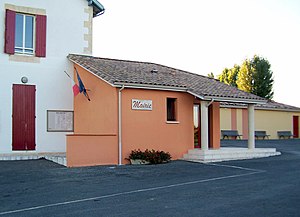Moustier
| Moustier | ||
|---|---|---|
|
|
||
| region | Nouvelle-Aquitaine | |
| Department | Lot-et-Garonne | |
| Arrondissement | Marmande | |
| Canton | Les Coteaux de Guyenne | |
| Community association | Pays de Lauzun | |
| Coordinates | 44 ° 38 ′ N , 0 ° 18 ′ E | |
| height | 35-113 m | |
| surface | 8.33 km 2 | |
| Residents | 326 (January 1, 2017) | |
| Population density | 39 inhabitants / km 2 | |
| Post Code | 47800 | |
| INSEE code | 47194 | |
 Mayor's Office ( Mairie ) of Moustier |
||
Moustier is a French municipality with 326 inhabitants (at January 1, 2017) in the department of Lot-et-Garonne in the region Nouvelle-Aquitaine (before 2016: Aquitaine ). The municipality belongs to the arrondissement Marmande and the canton Les Coteaux de Guyenne (until 2015: canton Duras ).
The name of the community comes from the Carolingian era and is derived from the Latin monasterium ( German monastery ).
The inhabitants are called Mousterriens and Mousterriennes .
geography
Moustier is located about 20 kilometers northeast of Marmande in the historic province of Agenais on the north-western edge of the department.
Moustier is surrounded by the five neighboring communities:
| Pardaillan | ||

|
La Sauvetat-du-Dropt | |
| Monteton | Allemans-you-Dropt | Roumagne |
Moustier lies in the catchment area of the Garonne River .
The Dropt , a tributary of the Garonne, forms the natural border with the neighboring municipalities of Allemans-du-Dropt, Roumagne and La Sauvetat-du-Dropt to the south and east. The Rieutord runs on the border with the neighboring municipality of Pardaillan to the west and flows into the Dropt on the border with Allemans-du-Dropt.
history
The area of the municipality was already settled in prehistory , as proven by numerous finds resulting from archaeological investigations in the hamlet of Ringaud on the banks of the Dropt. About ten fireplaces contained leftovers and various artifacts such as an ax made of carved stone and a brooch made of bronze . These found objects prove the presence of a settled people who went fishing and hunting, but at the same time also pursued cattle breeding.
Remnants from the Gallo-Roman period have also been discovered. These are vessels, fragments of marble or column elements . An important house, which undoubtedly belonged to a distinguished person, was on a step above the valley by the present cemetery and the old church. Another settlement was in what is now the hamlet of Sissac, north of the center of Moustier.
Archaeological excavations in 1958 also uncovered two sarcophagi from the Carolingian era at the present cemetery . They are made of gray limestone and are decorated with motifs. One of the two is trapezoidal and hatched, decorated with a paw cross on the foot . Its likewise fluted lid has the shape of a house roof. In 1967 more sarcophagi were lifted from three meters below the ground. These had flat lids, one with a triangular lock made of bronze . A sarcophagus is exhibited at the entrance to the cemetery today.
After the conquest by the Franks , monks settled in the area in the eighth century and built a large monastery in the vicinity of Moustier, which gave the community its name. They paved the way for population growth. The area suffered from raids by Normans in the years between 840 and 809 , which resulted in high blood tolls. During the 10th century the damaged churches were rebuilt.
In the following years the area came under the rule of the English crown and the Hundred Years War brought it back to France in the end. The resettlement then took place between 1500 and 1660. The immigrants came from all regions of France and received their land from the local seigneur . They were also open to the ideas of Calvinism and turned the village into a center of Protestantism . As a result, the population suffered in the Huguenot Wars until the revocation of the Edict of Nantes in 1685. By the beginning of the 18th century, the population fell victim to epidemics and famine, which spread over the country at intervals.
Population development
After the beginning of the records, the population rose to a high of around 605 by the middle of the 19th century. In the following period, the size of the community fell to around 275 inhabitants during short recovery phases up to the 1970s, before it reached a level of around 320 inhabitants could stabilize.
| year | 1962 | 1968 | 1975 | 1982 | 1990 | 1999 | 2006 | 2011 | 2017 |
|---|---|---|---|---|---|---|---|---|---|
| Residents | 325 | 323 | 277 | 301 | 320 | 302 | 311 | 339 | 326 |
Attractions
Parish Church of Saint-Hilaire
It is consecrated to Hilary of Poitiers , a bishop and doctor of the church . Today's church is a new building from 1865 to replace the earlier church from the 10th century, which was located near the cemetery and was demolished ten years later. From 1871 onwards, a bell tower and external stairs were added to the new church.
Le Croix de Moustier
It is a field cross west of the center of the municipality, around which there are many legends. It is said that in bygone times highwaymen made the place unsafe. According to a wicked legend, a witch's sabbath was celebrated at midnight. A hole was buried in the earth into which a black chicken was sacrificed with multiple incantations. That same night, or nine nights later, the devil himself appeared and gave silver or a black chicken with golden eggs in return for the sacrifice. So the Mousterriens sold their souls to get rich. At the end of the Huguenot Wars, some members of the parish who were more virtuous or jealous of those who had enriched themselves through the pact with the devil decided to put an end to the goings-on. They asked the pastor to put a sign of divine strength in this curse-laden place, a hall cross. From now on there was calm over the place.
Economy and Infrastructure

Moustier is located in the AOC zones of the wines of the Côtes de Duras growing area (blanc, blanc sec, rosé, rouge).

total = 17
education
The municipality has a public preschool and elementary school with 50 pupils in the 2018/2019 school year.
traffic
Moustier can be reached via route départementale 134, 309 and 668.
Web links
- Moustier on the Association of Municipalities website (French)
- Information on wines of the Côtes de Duras (French)
Individual evidence
- ^ A b Moustier ( fr ) Conseil régional d'Aquitaine. Archived from the original on March 3, 2016. Retrieved April 5, 2019.
- ↑ Lot-et-Garonne ( fr ) habitants.fr. Retrieved April 5, 2019.
- ^ Ma commune: Moustier ( fr ) Système d'Information sur l'Eau du Bassin Adour Garonne. Retrieved April 5, 2019.
- ^ Sarcophages du cimetière de Moustier ( fr ) Conseil régional d'Aquitaine. Archived from the original on March 12, 2016. Retrieved April 5, 2019.
- ^ Notice Communale Moustier ( fr ) École des Hautes Études en Sciences Sociales. Retrieved April 5, 2019.
- ↑ Populations légales 2016 Commune de Moustier (47194) ( fr ) INSEE . Retrieved April 5, 2019.
- ^ Église Saint-Hilaire ( fr ) Conseil régional d'Aquitaine. Archived from the original on March 3, 2016. Retrieved April 5, 2019.
- ↑ Legend de "La Croix de Moustier" ( fr ) Regional Council of Aquitaine. Archived from the original on March 3, 2016. Retrieved April 5, 2019.
- ↑ Institut national de l'origine et de la qualité: Rechercher un produit ( fr ) Institut national de l'origine et de la qualité . Retrieved April 5, 2019.
- ↑ Caractéristiques des établissements en 2015 Commune de Moustier (47194) ( fr ) INSEE . Retrieved April 5, 2019.
- ^ École maternelle et élémentaire ( fr ) National Ministry of Education. Retrieved April 5, 2019.




